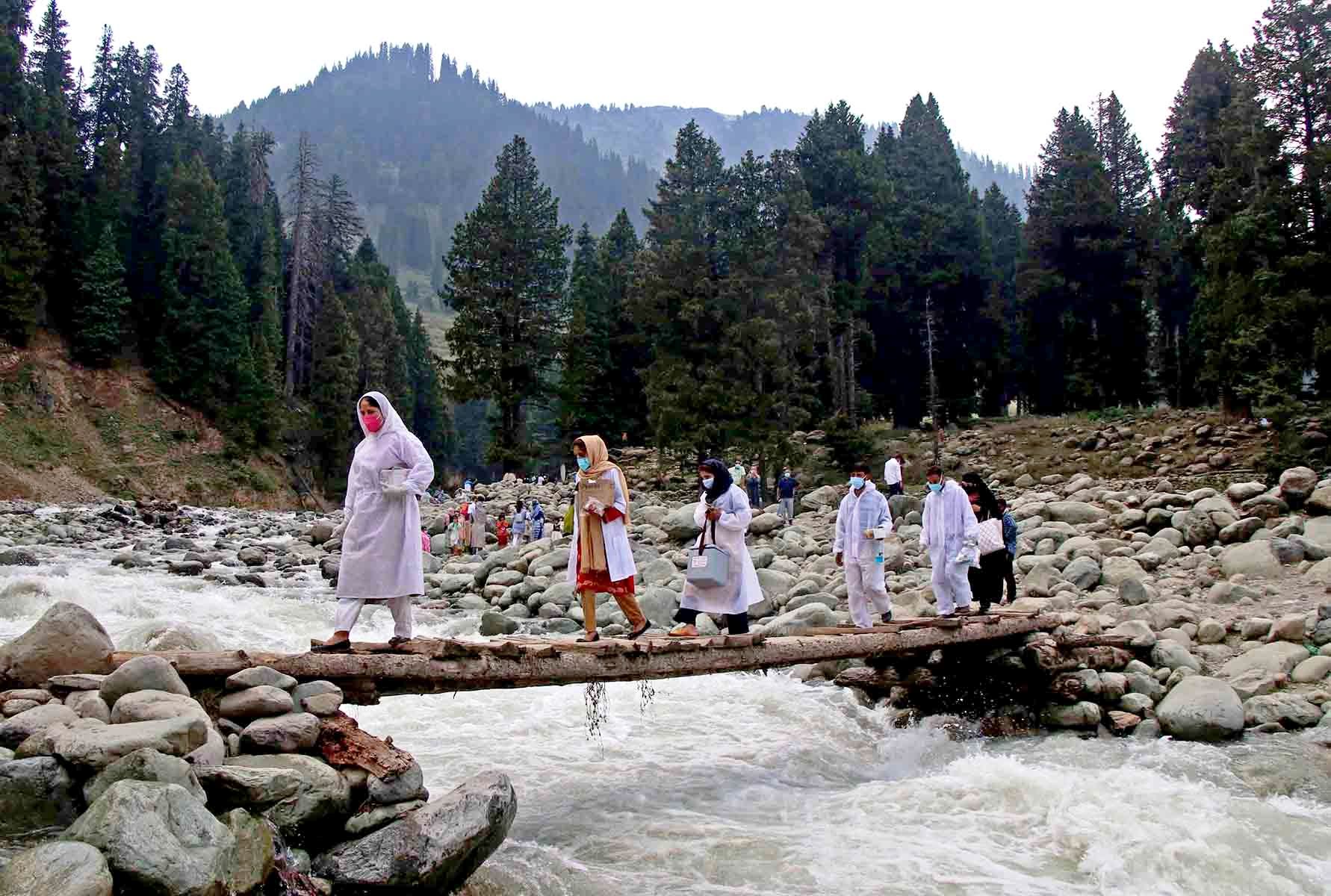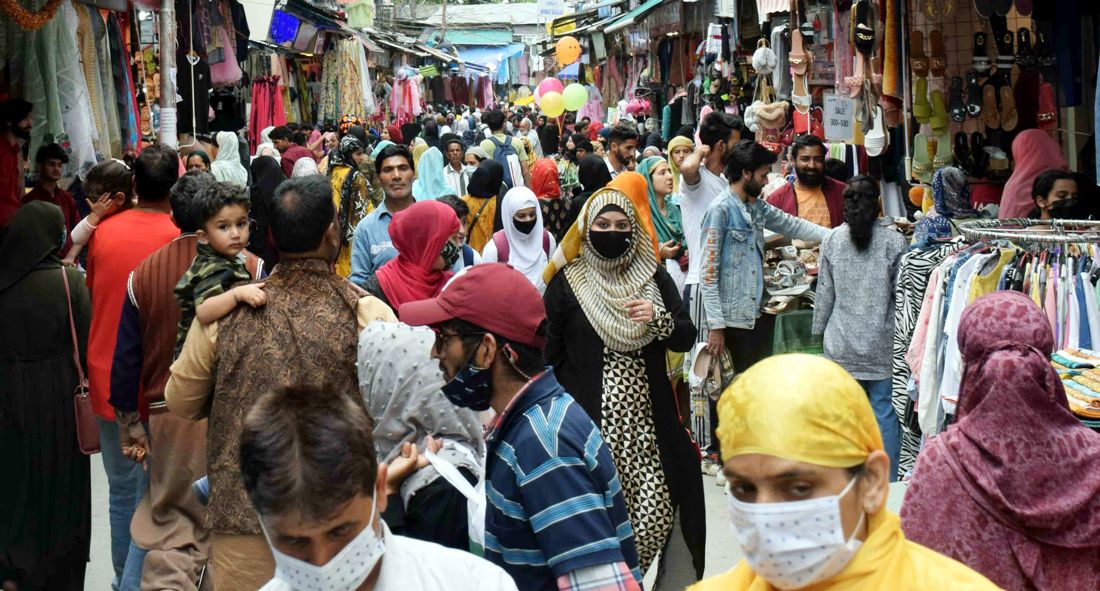The Greater Eid, the Eid al Azha that falls after the Haj pilgrimage is a major Muslim festival. However, the two-and-a-half-day festival that witnesses animal sacrifices the world over is not about the expenditure and the travel to revered sites but about piety and being closer to the Almighty, writes Tasavur Mushtaq

Sunday, June 5 was a day with a difference. It was shining in the continuum of clouds. The morning mood was mesmerizing. Smiles and sobbing were in sync. The white-dominated the demeanour. There was peace. The first batch of 145 Hajis flew from Srinagar to the holy city of Mecca.
Having remained suspended due to the Covid19 pandemic for two years, the pilgrimage was restored in 2022. Emotional scenes were witnessed. A cherished goal for a practising Muslim, there is always an intention to go for a Hajj. However, health and finances act as a trigger.
The Process
The practice of Hajj performed in its current form dates back to more than 1400 years. However, some of its elements go back to the time of the Prophet Ibrahim (AS) in 1813 BC.
One of the five pillars of Islam, the Hajj pilgrimage is held in the second week of Dhu’l Hijjah, the last month of the Islamic calendar. It lasts between four to six days, depending upon one’s speed and the arrangements around.
A mandatory religious requirement, it is one of the world’s largest mass gatherings. An obligation, Muslims able to do so are required to make this pilgrimage at least once in their lifetime. It is a journey, denoting both the outward act of physically travelling and the inward act of a person’s contemplation of their faith.
This journey is a lesson that regardless of social and economical strata, everybody is seen as equal before the Almighty.
The Pandemic
In times of ravaging pandemic, a picture of a lone worshipper in the house of Allah had gone viral. Muslims across the globe were terrified to see the scene. Invoking prayers and seeking forgiveness. Otherwise, in shoulder-to-shoulder situations, the busy holy cities presented a deserted look. Beyond a symbolic event of a few men performing the Hajj, the routine was paralyzed. The sky-scraping structures towering around Islam’s most sacred sites were desolated – empty environs, battered boundaries, lifeless lanes, shocking spaces and engulfing emptiness. Life and liberties had come to the halt. The buzzing businesses, from barbers to barons struggled to secure their existence. A message from the Almighty that what is seen as a right is actually a grace.

This sector was affected in Kashmir as well. Rough estimates suggest more than Rs 1500 crore of loss was incurred due to a halt in the Hajj operations to the travel and related industry. Over the years, Kashmir has evolved a huge pilgrim tourism set-up involving mostly the Umrah, Haj and travels to various sacred lands in Iran and Iraq.
The Economy
The Hajj and its allied activities have emerged as a lucrative business, linked intricately to the economy, however, beautifully. Helping individuals and industries grow, it provides massive economic opportunities as every year millions of pilgrims from around the world visit the twin Saudi cities of Makkah and Medina. According to a rough estimate, the holy pilgrimage adds an estimated US$ 12 to 13 billion to the economy of the oil-rich kingdom. This is the second-largest revenue generator for the region after hydrocarbons, comprising 20 per cent of the kingdom’s non-oil GDP and seven per cent of total GDP.
Every year as estimates suggested by the Mecca Chamber of Commerce reveals that the average foreign Hajj pilgrim spends around US$ 5000 to 7000, mainly on boarding, lodging, and purchasing gifts and souvenirs. The kingdom has a plan to host 30 million pilgrims and Umrah performers by the year 2030.
Kashmir is not alien to its benefits. As this year around 6072 pilgrims were sent through government channels, and the private players have their own share of seats. Roughly, more than 30,000 Muslims go every year for Hajj and Umrah from Jammu and Kashmir, spending roughly Rs 800 crore.
The government has withdrawn the subsidy component, making Hajj slightly expensive. However much it costs, the faithful will continue to visit the holy cities. They simply cannot do Hajj anywhere else.
The Qurbani
Qurbani means sacrifice. Having its origin in the word Qurb, meaning “closeness”, the message is how the Prophet Ibrahim (AS) was willing to sacrifice his son Hazrat Ismail (AS) and demonstrate his degree of submission and closeness to Allah. The same was true for the son as well. As far as the distribution of this meat is concerned, the guidelines require that one-third is consumed by the immediate family, one-third is gifted to friends and relatives, and the remaining one-third is donated to the poor. Recipients include non-Muslims as well. The concept is to ensure that benefits reach a large segment of society, irrespective of their faith, colour or creed. Even in certain cases, meat is sent to poor countries, like Africa.
 Essence apart, this activity is economically intensive and inclusive. It requires each pilgrim to sacrifice at least one animal before Hajj is declared complete. An accurate calculation would be too far. As per the data available, on average, the Kingdom consumes seven million sacrifices and if the average sacrifice goes by 800 Riyals, it will exceed sales of five billion Riyals. This is beyond the revenue generated by the product of sacrifice, hides.
Essence apart, this activity is economically intensive and inclusive. It requires each pilgrim to sacrifice at least one animal before Hajj is declared complete. An accurate calculation would be too far. As per the data available, on average, the Kingdom consumes seven million sacrifices and if the average sacrifice goes by 800 Riyals, it will exceed sales of five billion Riyals. This is beyond the revenue generated by the product of sacrifice, hides.
In Kashmir, on average, every year mutton dealers would record sales of sacrificial animals to the tune of Rs 500 crore. The pandemic had its impact, as well, bringing down the figure by at least 50 per cent in the last few years.
Like previous years, the government this year has also fixed the rates. For Delhi Walla and Merino Cross varieties of sheep have been fixed at Rs 310 per kg, those of Bakerwal and Kashmiri varieties at Rs 295 per Kg, and goat has been fixed at Rs 285 per Kg. Overall, this Eid, the rates have become costlier by Rs 25 per Kg. However, the people engaged in rearing the herds insist that the rate-fixers hardly come out of the ivory towers to understand how an animal grows, what are the costs it entails and how has inflation impacted their capacity.
The Essence
The required rituals of this elaborate practice go beyond the concept of commerce. The essence of this entire exercise is moving closer to the Almighty, both in thought and practice. Avoid Satan, both with spirit and body. Indeed this is the essence of Islam.
While the blessed souls are already in Islam’s most sacred land on the journey of their lifetime, there is a need to be unburdened of many things, important being the Ego. The vice-versa would be a disaster.
If there is one thing that separates man from God, it is an inflated ego. Referred to as an-nafs-ul-ammarah, mixed with kibr (arrogance), this combo is confident of leading mankind astray. One may argue that it is human to feel jealous when you see people around at better places than you, but it is not the way Muslims have been taught to think or believe. This is the worst and least forgivable form of jealousy when there is a feeling that Allah is showing more favour to someone else, someone we think doesn’t deserve it the way we do. Iblis has turned into what jealousy has done to him.
Symbolic stoning of the devil (rami al-jamarat), one of the important rituals, in Hajj is not about the symbolism of throwing stones at the wall. A stone hit on the wall can never be beneficial, unless it has an impact on the thrower. It is about conquering the inner self and annihilating the ego.

However, it would be too naïve to say that ego is something that can be curtailed forever. Never. It needs a regular conditioner. It will grow back, like our hair. But to stop it from becoming tangled, it needs a trim.
The fight against ego is the greatest struggle (Jihad al-Akbar) that a Muslim can endure.
Every step on the holy soil should help to flatten the inflated ego. This journey is to get a sense of sacrifice of self. Understand the dynamics of being mortals. Fragility and sinfulness.
Tailpiece
As pilgrims, now referred to as Hajjis are in Mecca, they perform Tawaf Al Ifadha, where they circumambulate the Kaaba one last time. Afterwards, they shed their white robes and don their finest charming and colourful clothes. But, changing the attire should not change an attitude. The key lies in stripping themselves of anything that could indicate social standing.
The uniformity is the uniqueness of this massive gathering. Rich or poor, young or old, black or white, nothing matters. There is no consideration for the class. What is being thought of as a must is just a myth?
This journey is effort-intensive. In another way, it teaches us that “with hardship comes ease”. While performing the rituals, there is subtle teaching of being patient and expecting mercy from the Almighty.
The stoning of Shaytan should be construed as writing on the wall that evil can be curbed. Stoned and stalled.
Further, the important activity of sacrifice is not only to slaughter the animal but should consist of honesty and humanity. Blood or flesh does not reach Allah, it is piety that matters.
While the rituals end, the reading should remain, forever.















